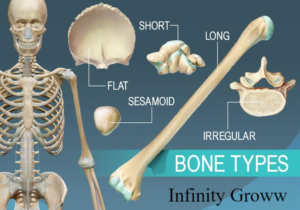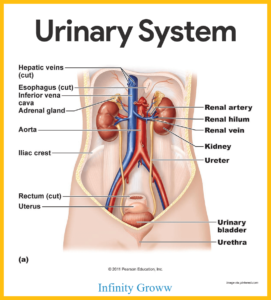Table of Contents
1. Introduction
1.1 Overview of the Integumentary System
1.2 Importance of Skin as a Protective Barrier
2. Anatomy of the Skin
2.1 Epidermis: The Outermost Layer
2.2 Dermis: Supporting the Skin Structure
2.3 Hypodermis: The Subcutaneous Tissue
3. Functions of the Integumentary System
3.1 Protection Against Pathogens and Injuries
3.2 Regulation of Body Temperature
3.3 Sensation: Nerves and Receptors in the Skin
4. The Role of Skin Appendages
4.1 Hair Follicles: Growth and Functions
4.2 Sebaceous Glands: Maintaining Skin Moisture
4.3 Sweat Glands: Cooling the Body
5. Common Skin Conditions
5.1 Acne: Causes and Treatment
5.2 Eczema and Dermatitis
5.3 Skin Cancer: Types and Prevention
6. Maintaining Healthy Skin
6.1 Proper Skincare Routine
6.2 Nutrition and Its Impact on Skin Health
6.3 Sun Protection and UV Radiation
7. Aging and the Integumentary System
7.1 Changes in Skin Structure with Age
7.2 Common Skin Issues in the Elderly
8. Injuries and Healing
8.1 Wound Healing Process
8.2 Scar Formation and Tissue Repair
9. Medical Interventions and Cosmetic Procedures
9.1 Dermatological Treatments
9.2 Plastic Surgery and Cosmetic Enhancements
10. Future Trends in Integumentary Research
10.1 Advances in Dermatology and Skin Health
10.2 Emerging Technologies in Skin Care
11. Conclusion
11.1 Recap of Key Concepts
11.2 The Ongoing Importance of Skin Health

1. Introduction :
- The integumentary system is a complex network of organs serving as the body’s primary defense mechanism.
- This section introduces the importance of the skin as a protective barrier.
1.1 Overview of the Integumentary System
-
The integumentary system comprises the skin, hair, nails, and glands.
-
Understanding its structure is crucial for comprehending functions and overall health.
1.1.1 Layers of the Skin
- Epidermis, dermis, and hypodermis contribute uniquely to system functionality.
1.1.2 Skin Appendages
1.2 Importance of Skin as a Protective Barrier
-
The skin acts as a robust barrier against external threats.
1.2.1 Physical Barrier
- The epidermis prevents the entry of pathogens, maintaining internal homeostasis.
1.2.2 Chemical Defense Mechanisms
- Antimicrobial peptides and fatty acids contribute to chemical defenses.
1.2.3 Microbial Flora and Skin Health
- A balanced microbial flora is crucial for protecting the skin and preventing infections.
2. Anatomy of the Skin :
The skin, the body’s largest organ, is a complex structure consisting of three main layers: the epidermis, dermis, and hypodermis. Each layer serves distinct functions, contributing to the overall structure and functionality of the integumentary system.

2.1 Epidermis: The Outermost Layer
- The epidermis is the outermost layer of the skin, providing the first line of defense against external threats.
- Composed mainly of epithelial cells, it serves as a protective barrier, preventing the entry of pathogens and substances.
- Specialized cells within the epidermis, such as melanocytes, contribute to pigmentation and protect against harmful UV radiation.
2.2 Dermis: Supporting the Skin Structure
- Beneath the epidermis lies the dermis, a connective tissue layer providing structural support to the skin.
- Collagen and elastin fibers in the dermis give the skin its elasticity and strength.
- Blood vessels, nerves, and various appendages, including hair follicles and sweat glands, are embedded in the dermal layer.
2.3 Hypodermis: The Subcutaneous Tissue
- The hypodermis, also known as the subcutaneous tissue, is located beneath the dermis.
- Composed of adipose tissue, it functions as an insulator, regulating body temperature.
- The hypodermis also serves as a cushion, providing protection to internal organs and structures.
3. Functions of the Integumentary System :
The integumentary system serves a multitude of functions, playing a vital role in maintaining overall health and homeostasis within the body.
3.1 Protection Against Pathogens and Injuries
- The skin acts as a physical barrier, preventing the entry of pathogens and foreign substances.
- The epidermis, through its tough and keratinized structure, offers protection against injuries, abrasions, and environmental hazards.
3.2 Regulation of Body Temperature
- The integumentary system plays a crucial role in thermoregulation.
- Sweat glands release perspiration, which evaporates and cools the body during overheating.
- Blood vessels in the dermis contribute to temperature regulation by constricting or dilating.
3.3 Sensation: Nerves and Receptors in the Skin
- Nerves and receptors in the skin allow for the perception of various stimuli, including touch, pressure, temperature, and pain.
- Specialized nerve endings in the dermis provide the body with essential information about its environment.
4. The Role of Skin Appendages :
Skin appendages, including hair follicles, sebaceous glands, and sweat glands, contribute significantly to the overall functions of the integumentary system.

4.1 Hair Follicles: Growth and Functions
- Hair follicles are responsible for the growth of hair, which provides sensory functions and protection.
- Hair follicles also play a role in regulating temperature by controlling the release of sebum.
4.2 Sebaceous Glands: Maintaining Skin Moisture
- Sebaceous glands produce sebum, an oily substance that moisturizes the skin and hair.
- Sebum helps prevent dehydration, dryness, and maintains the skin’s flexibility.
4.3 Sweat Glands: Cooling the Body
- Sweat glands release perspiration onto the skin’s surface.
- The evaporation of sweat helps cool the body during physical activity or elevated temperatures, preventing overheating.
5. Common Skin Conditions
The integumentary system is susceptible to various conditions that can impact its health and appearance. This section explores some common skin conditions and their causes and treatments.
5.1 Acne: Causes and Treatment
- Acne is a common skin condition characterized by the development of pimples, blackheads, and whiteheads.
- Causes include hormonal changes, genetics, and excessive oil production.
- Treatment options may include topical creams, antibiotics, or other medications.
5.2 Eczema and Dermatitis
- Eczema and dermatitis are inflammatory skin conditions leading to red, itchy, and irritated skin.
- Triggers may include allergens, irritants, or genetic factors.
- Management involves moisturizers, corticosteroids, and identifying and avoiding triggers.
5.3 Skin Cancer: Types and Prevention
- Skin cancer is a serious condition with various types, including melanoma, basal cell carcinoma, and squamous cell carcinoma.
- Prevention involves sun protection, regular skin checks, and early detection through screenings.
6. Maintaining Healthy Skin
Proactive care is essential for maintaining the health and vitality of the skin. This section explores practices and factors contributing to healthy skin.

6.1 Proper Skincare Routine
- A proper skincare routine involves cleansing, moisturizing, and sun protection.
- Choosing appropriate products for one’s skin type is crucial for optimal results.
6.2 Nutrition and Its Impact on Skin Health
- Proper nutrition, including vitamins and antioxidants, plays a vital role in supporting skin health.
- Hydration and a balanced diet contribute to the skin’s resilience and radiance.
6.3 Sun Protection and UV Radiation
- Protecting the skin from UV radiation is critical in preventing premature aging and reducing the risk of skin cancer.
- Sunscreen, protective clothing, and seeking shade are essential sun protection measures.
7. Aging and the Integumentary System
As the body ages, the integumentary system undergoes changes that can impact its appearance and function. This section explores the aging process and associated skin issues.
7.1 Changes in Skin Structure with Age
- Aging leads to a reduction in collagen and elastin, resulting in wrinkles and sagging skin.
- Changes in skin thickness and blood circulation contribute to altered skin appearance.
7.2 Common Skin Issues in the Elderly
- The elderly may experience skin issues such as dryness, bruising, and increased vulnerability to infections.
- Proper skincare and medical attention can address and manage these concerns.
8. Injuries and Healing
Injuries to the skin trigger a well-coordinated healing process. This section explores the phases of wound healing and the formation of scars.
8.1 Wound Healing Process
- The wound healing process involves three main phases: inflammation, proliferation, and remodeling.
- Blood clotting, immune response, and tissue regeneration are crucial components of this intricate process.
8.2 Scar Formation and Tissue Repair
- Scar formation is a natural part of the healing process, resulting from the deposition of collagen fibers.
- Factors such as wound size and depth influence the appearance and extent of scarring.
9. Medical Interventions and Cosmetic Procedures
Advancements in medical science offer various interventions for both medical and cosmetic purposes related to the integumentary system.
9.1 Dermatological Treatments
- Dermatological treatments address a range of skin conditions, including acne, psoriasis, and dermatitis.
- Therapies may involve topical medications, light-based treatments, or systemic medications.
9.2 Plastic Surgery and Cosmetic Enhancements
- Plastic surgery and cosmetic procedures aim to improve aesthetic appearance.
- Common interventions include facelifts, botox injections, and laser resurfacing for skin rejuvenation.
10. Future Trends in Integumentary Research
Ongoing research in dermatology and skin health contributes to advancements in understanding and treatment.
10.1 Advances in Dermatology and Skin Health
- Ongoing research explores new treatments for skin conditions, including innovative medications and therapies.
- Precision medicine and personalized skincare are emerging trends in dermatological research.
10.2 Emerging Technologies in Skin Care
- Technology plays a significant role in skincare with the development of wearable devices and apps.
- Advances in nanotechnology and gene editing show promise in future skincare interventions.
Fascinating Facts about the Integumentary System:
- The skin is the largest organ of the human body, comprising about 16% of body weight.
- Humans shed millions of skin cells daily, which are replaced every 28 to 30 days.
- Fingernails grow about 3 mm per month, while toenails grow at a slower pace of about 1 mm per month.
- Hair is incredibly strong and can support the weight of two elephants.
- Goosebumps occur when tiny muscles at the base of hair follicles contract in response to cold or emotional stimuli.
- The skin can regenerate itself even after severe burns, injuries, or wounds, often leaving minimal scarring.
- Every square inch of skin contains about 650 sweat glands.
- The skin’s color is determined by the amount of melanin produced, with variations across different ethnicities and regions.
- UV rays from the sun can cause premature aging of the skin, leading to wrinkles and age spots.
- Regular exercise and a balanced diet contribute to healthy skin, as physical activity improves blood circulation and nutrient supply to the skin cells.
Understanding the functions, roles, and fascinating facts of the integumentary system highlights its importance in maintaining overall health and well-being. Proper care and attention to this remarkable system contribute to healthy, vibrant skin and support the body’s vital functions.
Components of the Integumentary System:
The integumentary system is a complex system that consists of several key components working together to perform essential functions. Let’s explore each component in-depth, including its individual function, role, importance, and some interesting facts:
-
Skin (Cutaneous Membrane):
- Function: The skin is the largest and most visible component of the integumentary system. It serves as a protective barrier against external threats, such as microorganisms, UV radiation, chemicals, and physical injuries.
- Role: The skin helps regulate body temperature through sweating and blood vessel dilation or constriction. It also houses sensory receptors for touch, pressure, pain, and temperature perception.
- Importance: The skin’s protective function is crucial for overall health, preventing infections and preserving internal homeostasis.
-
Epidermis:
- Function: The epidermis is the outermost layer of the skin, consisting of multiple cell layers. It provides waterproofing and protects against water loss.
- Role: This layer contains melanocytes, which produce melanin, the pigment responsible for skin color and protection against harmful UV rays.
- Importance: The epidermis plays a vital role in shielding the body from external damage and UV-induced skin disorders.
-
Dermis:
- Function: The dermis lies beneath the epidermis and contains blood vessels, nerves, hair follicles, and sweat glands. It provides structural support to the skin.
- Role: The dermis is responsible for thermoregulation, as it houses sweat glands that secrete perspiration to cool the body and blood vessels that dilate or constrict to regulate temperature.
- Importance: It also plays a role in sensory perception and nourishing the epidermis with oxygen and nutrients.
-
Subcutaneous Tissue (Hypodermis):
- Function: The subcutaneous tissue is a layer of fat and connective tissue located beneath the dermis. It serves as insulation and energy storage.
- Role: This layer helps regulate body temperature and protects internal organs from mechanical trauma.
- Importance: The subcutaneous tissue provides cushioning and support to the skin and contributes to body contour.
-
Hair and Hair Follicles:
- Function: Hair and hair follicles are distributed across the skin’s surface. Hair provides additional protection against physical injuries and UV radiation.
- Role: Hair follicles produce hair, and the arrector pili muscles attached to them are responsible for causing goosebumps.
- Importance: While human body hair is less significant for protection in modern times, it still serves as a sensory organ and contributes to temperature regulation.
-
Nails:
- Function: Nails are hard, keratinized structures located at the fingertips and toes.
- Role: They protect the sensitive tips of fingers and toes from injuries and assist in gripping and manipulation.
- Importance: The condition of nails can sometimes reflect overall health, and changes in nail appearance may indicate underlying health issues.
Fascinating Facts:
- The skin is thickest on the palms of the hands and soles of the feet, and thinnest on the eyelids.
- Skin color is influenced by genetics, sun exposure, and the amount of melanin produced by melanocytes.
- Nails grow faster in warm climates and during pregnancy.
- The skin of a newborn is more sensitive and susceptible to damage than adult skin.
- Skin cells are constantly regenerating and shedding, with the entire epidermis being replaced about every 27 days.
Understanding the components of the integumentary system and their functions highlights the system’s complexity and significance in protecting the body, maintaining temperature, and enabling sensory perception. Proper care and attention to each component contribute to overall skin health and well-being.
Diseases Associated with the Integumentary System:
The integumentary system is prone to various diseases and disorders that can affect the skin, hair, nails, and associated structures. Understanding these conditions is crucial for timely diagnosis and effective management. Let’s delve into some common diseases associated with the integumentary system, including their definitions, causes, symptoms, treatments, and the Ayurvedic approach:
-
Acne:
- Definition: Acne is a common skin condition characterized by the formation of pimples, blackheads, and whiteheads due to clogged hair follicles and excess sebum production.
- Cause: Hormonal changes, excessive oil production, bacteria, and certain medications can contribute to acne development.
- Symptoms: Red, inflamed bumps, blackheads, and pus-filled lesions are typical symptoms.
- Treatment: Topical treatments containing benzoyl peroxide or salicylic acid, oral antibiotics, and retinoids are commonly used. Severe cases may require hormonal therapies or isotretinoin.
- Ayurvedic Approach: Ayurvedic treatment for acne involves herbal remedies, dietary modifications, and lifestyle changes. Neem, turmeric, and aloe vera are often used for their anti-inflammatory and antimicrobial properties.
-
Eczema (Dermatitis):
- Definition: Eczema is a group of inflammatory skin conditions that cause red, itchy, and dry skin patches.
- Cause: Genetics, environmental triggers, allergens, and immune system dysfunction can contribute to eczema flare-ups.
- Symptoms: Itchy, red, and scaly patches on the skin, often accompanied by swelling and blisters.
- Treatment: Moisturizers, corticosteroid creams, antihistamines, and immune-modulating medications are commonly prescribed.
- Ayurvedic Approach: Ayurvedic treatment aims to balance the doshas (Vata, Pitta, and Kapha) and may include herbal remedies like turmeric, licorice, and ashwagandha.
-
Psoriasis:
- Definition: Psoriasis is a chronic autoimmune skin disease characterized by rapid skin cell growth, leading to thick, silvery scales and red patches.
- Cause: Genetics, immune system abnormalities, and environmental triggers are thought to contribute to psoriasis.
- Symptoms: Thickened, red, and scaly skin patches, often accompanied by itching and pain.
- Treatment: Topical treatments, phototherapy, systemic medications, and biologic therapies are used to manage psoriasis.
- Ayurvedic Approach: Ayurvedic treatment involves purifying the blood, detoxification, and herbal remedies like neem, guggulu, and manjistha.
-
Skin Infections (Fungal, Bacterial, Viral):
- Definition: Various fungal, bacterial, and viral infections can affect the skin, causing rashes, blisters, and lesions.
- Cause: These infections are usually caused by exposure to pathogens in the environment or through direct contact with infected individuals.
- Symptoms: Symptoms vary depending on the type of infection but may include itching, redness, pain, and fluid-filled blisters.
- Treatment: Antifungal, antibacterial, or antiviral medications are prescribed based on the specific infection.
- Ayurvedic Approach: Ayurvedic remedies like neem, turmeric, and holy basil have natural antimicrobial properties and can aid in managing skin infections.
Importance:
Maintaining the health of the integumentary system is crucial for overall well-being. Skin diseases can cause discomfort, pain, and social distress. Early diagnosis and appropriate treatment, whether conventional or Ayurvedic, play a significant role in managing these conditions and improving the quality of life for affected individuals. Adopting a holistic approach to skincare, along with a balanced diet and lifestyle, can help promote skin health and prevent the onset of certain skin diseases.
11. Conclusion
In this final section, the key concepts are summarized, emphasizing the ongoing importance of skin health.
11.1 Recap of Key Concepts
- A brief summary of the essential concepts discussed throughout the book, from the anatomy of the skin to common conditions and interventions.
11.2 The Ongoing Importance of Skin Health
- A concluding statement on the continuous significance of maintaining skin health for overall well-being.
- Encouragement for ongoing awareness, care, and advancements in integumentary research.







